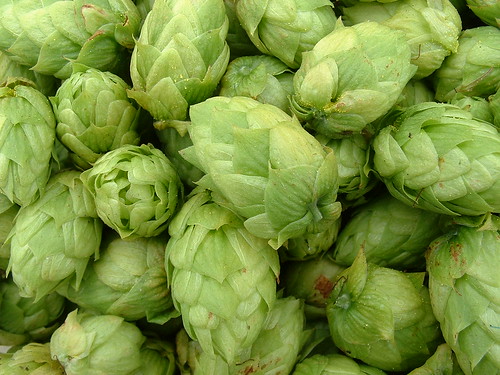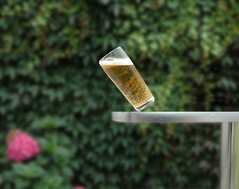 By now, anyone who's been to a respectable beer bar and tried to order an IPA has surely heard of IBUs, and might even be aware of a link between this number (a measurement of bitterness) and how much hops the brewer used. But there's much more to consider here that gets lost on most drinkers.
By now, anyone who's been to a respectable beer bar and tried to order an IPA has surely heard of IBUs, and might even be aware of a link between this number (a measurement of bitterness) and how much hops the brewer used. But there's much more to consider here that gets lost on most drinkers.Indulge me for a second with a geeky analogy from another realm. The situation with IBUs reminds me of a similar one a few years ago in the chip wars between Intel and AMD. Chips used to be marketed by their clockspeed in GHz. This gave the consumer a nice, simple way to compare the performance of two chips or the PCs running them without having to be a computer engineer or understand the underlying architectures. It was a very convenient tool for consumers and was widely exploited by manufacturers.
The problem was that the number by itself was useless; Intel figured out how to increase their chip's clock speed by doing less work per clock tick (and thereby generating less heat and allowing them to run "quicker"). The result was that an AMD chip had better technology and would outperform an Intel chip with the same GHz number on it. But they were also more expensive and because the numbers were the same, consumers would pick the cheaper Intel chip, never fully understanding the real issues affecting performance. This led to a really ugly situation where AMD started using their own proprietary (and subjective) numbering schemes that didn't really allow the consumer to casually compare performance at all. Thus the irresponsible use of this number as a marketing tool rendered it utterly useless to consumers. I fear the same thing might be starting to taking place as we speak in the crowded world of IPAs and other highly hopped beers.
IBU stands for International Bittering Unit, and is a measure of how much hop bitterness is present in a beer. The craft beer market in the US caters to a rebellious lot of consumers that are shunning the characteristics of mass-produced fizzy yellow lagers, particularly by actively seeking intensely flavored and highly hopped beers. The IBU has become the latest tool in the craft beer marketer's kit, letting drinkers see at a glance which IPA is most intense and hoppy, and therefore better... but this number alone can't tell you that, and it's important for consumers to understand why.
 First, one pivotal key to brewing a good beer is balance. An intensely hopped, bitter IPA is not going to taste right if this bitterness is not balanced by malty sweetness. There's a simple rule of thumb for calculating how balanced a beer is, using a value known as the BU/GU ratio, which I will cover more completely in a later article. Essentially it is Bittering Units (IBUs) divided by Gravity Units, which is a measure of how much residual sugar is left dissolved in the beer after fermentation, the rest having been converted to alcohol. (Brewers typically use the original gravity, i.e. before fermentation takes place, in the BU/GU calculation, but it is still a decent proxy for the residual sweetness since attenuation-the portion of available sugar fermented-of most yeast strains typcially doesn't vary enough to throw off the results.)
First, one pivotal key to brewing a good beer is balance. An intensely hopped, bitter IPA is not going to taste right if this bitterness is not balanced by malty sweetness. There's a simple rule of thumb for calculating how balanced a beer is, using a value known as the BU/GU ratio, which I will cover more completely in a later article. Essentially it is Bittering Units (IBUs) divided by Gravity Units, which is a measure of how much residual sugar is left dissolved in the beer after fermentation, the rest having been converted to alcohol. (Brewers typically use the original gravity, i.e. before fermentation takes place, in the BU/GU calculation, but it is still a decent proxy for the residual sweetness since attenuation-the portion of available sugar fermented-of most yeast strains typcially doesn't vary enough to throw off the results.)Even understanding this simple ratio does little to help the consumer, however, as the gravity figures are not touted as frequently as the IBUs. Even if you used alcohol content as a proxy for original gravity (which is feasible but troublesome for the same reason OG doesn't correspond perfectly to residual sweetness), there are many other factors that can affect the percieved balance of a beer.
The second issue with the IBU rating has to do with the chemical reactions that take place during the boil. Hops contain many chemical compounds that affect the character of beer, but for our purposes we'll focus on two groups: alpha acids and hop oil compounds. As the hops stew in the boiling wort, two things happen: alpha acids undergo a chemical reaction known as isomerization, which produces the bitterness that hops are known for. The other is that the volatile compounds in hop oils, which provide a rich tapestry of flavor and aroma to the finished beer, are slowly boiled away and lost forever. Therefore, hops that are added near the end of the boil (or even after the boil in a hopback or during conditioning in a process called dry hopping) will impart more flavor and aroma to the brew since the compounds don't boil off, but will add much less in the way of bitterness (i.e. lower IBUs).
So what does it all mean? Higher IBUs do not indicate a better beer, by any stretch of the imagination. They measure bitterness, but say nothing about balance. Furthermore, bitterness comes from hops, but unscrupulous brewers can goose their IBU numbers and attract more attention by boiling all of the delicate hop oil flavor out of their hops to extract the maximum bitterness. Just be aware of this the next time you belly up to the bar for an IPA and are greeted by the "convenience" of having IBU numbers in front of you. Judge beers by taste, not by numbers.





No comments:
Post a Comment